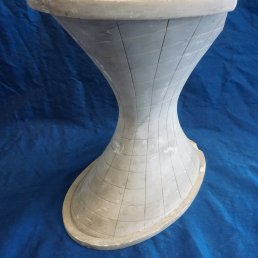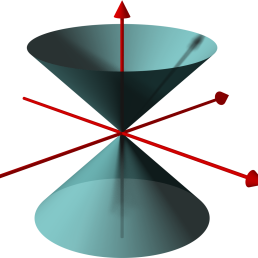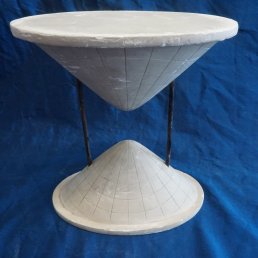Algebraic Geometry
Introduction
As its name suggests, algebraic geometry deals with curves or surfaces (or more abstract generalisations of these) which can be viewed both as geometric objects and as solutions of algebraic (specifically, polynomial) equations. A simple example is a circle of radius 1, which is the set of all points which are at a unit distance from its centre, but it is also the set of points $(x,y)$ satisfying $x^2 + y^2 -1 = 0$. What geometric properties can be inferred from the equation? What about more complicated polynomial equations such as the semicubical parabola $y^2 - x^3 = 0$, which has a cusp at its tip (such "singularities" are of great importance), or something less intelligible such as $x^2 -x^2y^2 + y^3 + xy -1 = 0$? And, intriguingly, what if we change the minus sign in the equation for a circle to a plus, so that it reads $x^2 + y^2 + 1 =0$? Now $x$ and $y$ have to be complex, or there are no solutions at all. What does this imply?
Algebraic geometry sets out to answer these questions by applying the techniques of abstract algebra to the set of polynomials that define the curves (which are then called "algebraic varieties"). The mathematics involved is inevitably quite hard, although it is covered in degree-level courses. Other common questions in algebraic geometry concern points of special interest such as singularities, inflection points and points at infinity - we shall see these throughout the catalogue. More advanced questions in algebraic geometry concern relations between curves given by different equations and the topology of curves, and many other topics.
The Study of Algebraic Geometry
Algebraic geometry grew significantly in the 20th century, branching into topics such as computational algebraic geometry, Diophantine geometry, and analytic geometry. An area of particular significance here is singularity theory, which we shall visit later. We have many models which illustrate the classification of singularities on algebraic varieties.
Algebraic geometry is a very abstract subject, studied for beauty and interest alone. However, there are always interesting applications of pure mathematics, with algebraic geometry no exception - see here for an interesting discussion. In algebraic statistics, techniques from algebraic geometry are used to advance research on topics such as the design of experiments and hypothesis testing [1]. Another surprising application of algebraic geometry is to computational phylogenetics [2,3]. See [4] for more on the applications of algebraic geometry.
Singularities
Consider a hyperboloid of one sheet, a cone, and a hyperboloid of two sheets (shown below). Imagine 'morphing' between the one-sheet and two-sheet hyperboloids - the point at which we pass from one case to the other is the cone. On the cone, there is a singularity in the centre. Studying singularities is a crucial tool in geometry, as they occur at the 'boundary' of two different forms of behaviour. For example, the number of components of the surface changes here from one to two.
Surfaces defined by algebraic equations are "smooth" at almost all their points - by this we mean that, if you look closely enough, the surface looks like a plane ($\mathbb{R}^2$). A "singularity" (or "singular point") of an algebraic surface $f(x,y,z) = 0$ is a point at which it is not smooth, for example having a 'cusp' or a 'ridge'.
In a small neighbourhood of a singular point, the surface fails to resemble $\mathbb{R}^2$. This can be made more precise using topology: the surface does not locally resemble a manifold at singular points.
It can also be helpful to look at just the real points on a surface, i.e. just those with coordinates in $\mathbb{R}$, satisfying the equation of the surface. We will speak of singularities as being "real" if they are singularities of the surface defined over the reals, and "complex" otherwise.
In the context of singularities, mathematicians are often found to ask questions such as "Do they exist?", "How many are there?", and "How can we classify them?". All of these fundamental questions are prevalent throughout mathematics, especially so in the fascinating topic of enumerative geometry.
Rings, Ideals, and Polynomial Rings (things get trickier from here onwards!)
Rings are a very powerful and useful object of study, especially within the topic of commutative algebra. A "ring" is a set together with two "operations", and can be thought of as a generalisation of the (positive and negative) integers with operations $+$ and $\times$. Ring theory dates back to the 19th century, and has grown substantially with lots of mathematical topics, especially algebraic geometry, now relying on it.
An "ideal" is a special subset of a ring. An ideal is self-contained with respect to addition, and multiplying anything by a member of the ideal gives another member of the ideal. Intuitively, this generalises special subsets such as the even numbers within the integers. This term was coined by eminent German mathematician Richard Dedekind in the late 19th century, inspired by the notion of an ideal number.
A ring is "Noetherian" if all its ideals are finitely generated. This means that all members of an ideal can be found by "adding" and "multiplying", from some finite collection of starting elements. Working with such ideals is often desirable. Noetherian rings are named after Emmy Noether, who developed the foundation of modern commutative ring theory in 1921 with her landmark paper "Idealtheorie in Ringbereichen" [5].
Given a ring $R$, its corresponding "polynomial ring" is the set of all 1 variable polynomials whose coefficients are members of $R$, and is denoted $R[X]$. For example, the integers $\mathbb{Z}$ have polynomial ring $\mathbb{Z}[X]$ containing elements such as $x^2 +3x -7$ but not $x^3 -\frac{1}{2} x +6$, which has a non-integer coefficient.
Algebraic Varieties, and 2 Key Results
In algebraic geometry, the main objects of interest are "algebraic varieties", which are essentially geometric manifestations of solutions to polynomial equations. Some familiar examples include spheres, conic sections, and lines in $\mathbb{R}^2$ (two-dimensional Euclidean space). Algebraic surfaces can be thought of as particularly simple algebraic varieties, defined by only one polynomial equation. Our collection of mathematical models exhibits a range of interesting properties of algebraic surfaces.
We are now ready to appreciate two important results of the great German mathematician David Hilbert.
Hilbert's Nullstellensatz, proven in 1890, is a remarkable theorem which helps establish the fundamental link between algebraic varieties and ideals in polynomial rings, thus unifying algebraic geometry and commutative algebra. Hilbert's Basis Theorem, also from 1890, says that for any Noetherian ring, its "polynomial ring" is also Noetherian. The upshot of these results is a solid foundation for working with algebraic varieties. For some (advanced) further reading, have a look at Terence Tao's blog post on Hilbert's Nullstellensatz. Tao's blog provides excellent reading for those interested in finding out about current mathematical research.
Projective Space
A "field" is a special case of a ring, in which every non-zero element has a multiplicative inverse. This means that fields have a "division" operation analogous to what we have with real numbers. Indeed, the real numbers form a field. The integers do not, as $1/n$ is not an integer for $n \neq \pm 1$. (Note that when learning about new mathematical concepts, it is often very helpful to find such non-examples as well as examples of the concept itself)
A vector space (defined "over a field") is a set containing points, which we can add together and multiply by scalars (i.e. members of the field). This generalises $\mathbb{R}^n$, familiar Euclidean space of dimension $n$, in which we can add coordinates together, and multiply (stretch) vectors by real numbers.
"Projective space", denoted $\mathbb{P}^n$, is defined with respect to a field. It is perhaps best understood as a "quotient space", but can also be thought of as "the set of all lines through the origin" in a vector space (over a field). As a quotient space, for some $n+1$-dimensional vector space $V$, projective space $\mathbb{P}^n$ is the set of all points in $V$ equated up to scalar multiples, with the origin removed. Note that this is the same as the set of lines through the origin. This gives rise to the notion of "homogeneous coordinates" (also called "projective coordinates"), which are the standard coordinate system for describing points in projective space. Many of our models represent surfaces in projective space, and are defined using homogeneous coordinates.
A relatively easy projective space to visualise is the projective plane $\mathbb{P}^2$, which can be attained by taking all points on a sphere, and "gluing" antipodal points together. For a slightly more thorough introduction to projective space, see here.
Dimension and Degree
An algebraic surface may also be thought of as an algebraic variety of dimension two. The notion of dimension of an algebraic variety generalises the notions of dimension for the more familiar Euclidean space or a vector space. The dimension of a given variety can be defined as the greatest length $d$ of a chain of distinct sub-varieties $X_{0} \subset X_{1} \subset \dots \subset X_{d}$ all contained within each other. For example: a point, line, and plane can form a maximal chain with $l=2$, so a plane has dimension two, and is hence a (degenerate) algebraic surface. A complex cubic surface is an algebraic surface in $\mathbb{P}^3$, over the field $\mathbb{C}$ of complex numbers. Recall the definition of the solutions to polynomial equations are considered over the complex numbers rather than the reals, and the polynomials involved can have complex coefficients).
An important property of an algebraic surface is its "degree" (also known as "order"), which may be thought of as the "total degree" of the polynomial defining it. Total degree refers to the sum of the exponents of variables. For example, the polynomial defined by $f(x, y, z) = x^3 y - 2y^2 z + z^3$ has total degree four. For the more general case of an algebraic variety, the notion of degree is more complicated. It is defined using intersection theory. We have lots of models of algebraic surfaces of order 2, 3, and 4, respectively named quadric, cubic, and quartic surfaces. There are also a few surfaces of higher degree.
[show-siblings]
References
[1] M. Drton et al, Lectures on Algebraic Statistics (2008) https://math.berkeley.edu/~bernd/owl.pdf
[2] B. Cipra, Algebraic Geometers See Ideal Approach to Biology, http://siam.org/pdf/news/1146.pdf
[3] E. Allman & J. Rhodes, Phylogenetics and Algebraic Geometry: Problems from Biology (2005), http://www.dms.uaf.edu/~eallman/Papers/mega.pdf
[4] Chandrajit L Bajaj, Algebraic Geometry and its Applications, https://www.cs.princeton.edu/~chazelle/pubs/DecompAlgoGeom.pdf
[5] D. Berlyne, Ideal Theory in Rings (Translation of "Idealtheorie in Ringbereichen" by Emmy Noether ), http://arxiv.org/pdf/1401.2577v1.pdf




